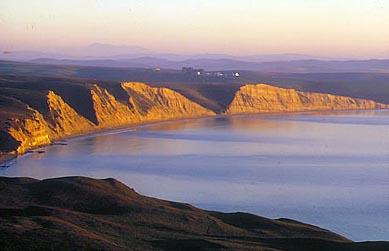America's NOAA-administered National System of Marine Protected Areas (MPAs) was established on May 26, 2000, by authority of Executive Order 13158.
The official federal definition of an MPA in Executive Order 13158 is: “any area of the marine environment that has been reserved by federal, state, tribal, territorial, or local laws or regulations to provide lasting protection for part or all of the natural and cultural resources therein.” In practical terms, marine protected areas are delineated areas in the oceans, estuaries, and coasts with a higher level of protection than prevails in the surrounding waters.
Only the marine portion of a site (below the mean high tide mark) is considered the MPA. The terrestrial part of a protected area site is not part of the MPA system.
The initial listing of MPA sites, presented earlier this year, consisted of areas already set aside under other legislation. Other sites have been added incrementally through a nomination and review process that carefully evaluates sites using a variety of relevant criteria.
System membership currently stands at 254 sites encompassing 175,000 square miles. You can see the complete list of MPAs at this site. The MPAs are listed by state at this site.
National Park System areas are poised to play a vital role in the national system, already accounting for ten percent of the membership and some of the key natural and cultural heritage sites. More than two dozen National Park System sites have been nominated so far for membership in the National System of Marine Protected Areas, and the 26 NPS sites listed below have already been formally accepted into the system.
• Assateague Island National Seashore
• Biscayne National Park
• Canaveral National Seashore
• Cape Cod National Seashore
• Cape Hatteras National Seashore
• Cape Lookout National Seashore
• Channel Islands National Park
• Dry Tortugas National Park
• Everglades National Park
• Fire Island National Seashore
• Gateway National Recreation Area
• Glacier Bay National Park & Preserve
• Golden Gate National Recreation Area
• Indiana Dunes National Lakeshore
• Isle Royale National Park
• Jean Lafitte National Historical Park & Preserve
• Kalaupapa National Historical Park
• Kaloko-Honokahau National Historical Park
• National Park of American Samoa
• Olympic National Park
• Pictured Rocks National Lakeshore
• Point Reyes National Seashore
• Salt River Bay National Historical Park & Ecological Preserve
• San Juan Island National Historical Park
• Sleeping Bear Dunes National Lakeshore
• Virgin Islands National Park
Since the National Park System has various other sites on the Atlantic, Gulf, Pacific, and Great Lakes (Acadia National Park, Padre Island National Seashore, Cabrillo National Monument, and Apostle Islands National Lakeshore, to name just four), the tally of Park Service-administered sites in the national system is destined to expand.
Membership in the National System of MPAs provides a wide range of benefits to the participating MPAs and various ocean stakeholders. Among the more prominent returns that NOAA cites are:
• Enhanced stewardship through better coordination, public awareness and enhanced site management capacity.
• Building partnerships for MPAs to work together toward common conservation objectives including access to participation in broader geographic coordination and planning activities.
• Increased support for marine conservation through the recognition provided by the national system.
• Protecting representative ecosystems and resources from all the nation's ecosystem and habitat types.
• Identifying gaps in current protection of ocean resources to help inform future MPA planning.
• Transparent process for MPA planning that is science-based and includes a commitment to balanced stakeholder.
Although the National System of Marine Protected Areas fosters collaboration among participating MPA sites and programs to enhance stewardship in U.S. waters, it does not establish new regulatory authority or interfere with the exercise of existing agency authorities.




Add comment